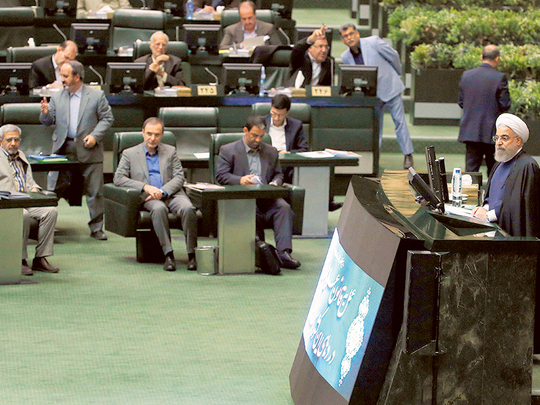
Dubai: Iranian President Hassan Rouhani proposed on Sunday a state budget of about $100 billion (Dh367 billion) for next year, loosening the purse strings to support economic growth as Donald Trump’s election threatens to put renewed pressure on Tehran.
The US president-elect said during his campaign that he would scrap last year’s nuclear agreement between Iran and world powers, in what would be a big blow to the Iranian economy just as it emerges from years of sanctions.
Rouhani announced a draft budget for the Iranian year that will start on March 21 of 3,200 trillion rials ($99.7 billion at the official exchange rate), excluding state enterprises. That is up 9 per cent from the plan for the current year.
“Maintaining the growth rate that was launched in the [current] year is the main economic issue for the country and all economic policies should be designed around this axis,” Rouhani told parliament in a speech carried live by state television.
After struggling for years under sanctions, Iran’s economy has picked up after most restrictions were removed in January under a deal with world powers on Tehran’s nuclear programme.
The International Monetary Fund estimates growth of 4.5 per cent this year, up from just 0.4 per cent last year.
But Rouhani is under pressure to sustain economic growth as his hardline opponents, who were against the nuclear agreement, say he has failed to improve living standards as much as hoped after the lifting of sanctions. The next presidential elections are due in mid-2017.
Uncertainty
Trump’s pledge to scrap the nuclear deal may mean his administration will reimpose sanctions or at least interpret remaining ones more stringently.
Even if Trump takes no concrete action, uncertainty over Washington’s intentions in the next few years could make companies around the world more cautious about trading with or investing in Iran, limiting the economic boost which Rouhani hoped to gain from the nuclear deal.
So the draft budget partially loosens the conservative fiscal policy which Rouhani adopted after taking power in 2013.
Taking into account inflation running at about 9 per cent, next year’s draft budget envisages roughly zero spending growth in real terms.
The current year’s budget, compiled when inflation was considerably higher, represents a rise of slightly over 7 per cent from the previous year’s plan.
“We hope to end the [current] year with single-digit inflation, a 5 per cent growth rate and the creation of 700,000 new jobs,” Rouhani said in his speech.
As in past years, the draft budget shows spending and revenues in balance, although the actual result will depend on fluctuations in oil prices. Next year’s budget assumes oil prices of $45-$55 per barrel, Iranian news agencies reported, up from $40 for the current year’s budget.
The draft budget has to be passed by parliament and approved by a clerical body that vets legislation before it becomes law.
Factbox: Opec deal boosts Iran budget
Iran’s President Hassan Rouhani presented his budget Sunday, with Opec’s decision to cut production helping to boost its expected oil revenues.
Rouhani’s 2017-2018 budget is based on oil prices of $50 per barrel, up from $40 last year, with a focus on unemployment, water resources, railways and the environment.
The sums look realistic after last week’s historic agreement by the 14-member Organisation of the Petroleum Exporting Countries (Opec) to cut production by 1.2 million barrels per day (bpd), which has already boosted oil prices to over $50.
Iran was exempted from the cuts as it seeks to regain the market share it lost during years of international sanctions.
Since sanctions were lifted in January under a nuclear deal with world powers, its oil production has risen from 2.7 million bpd to 3.8 million, Rouhani said, and it aims to hit almost 4 million bpd by mid-2017.












